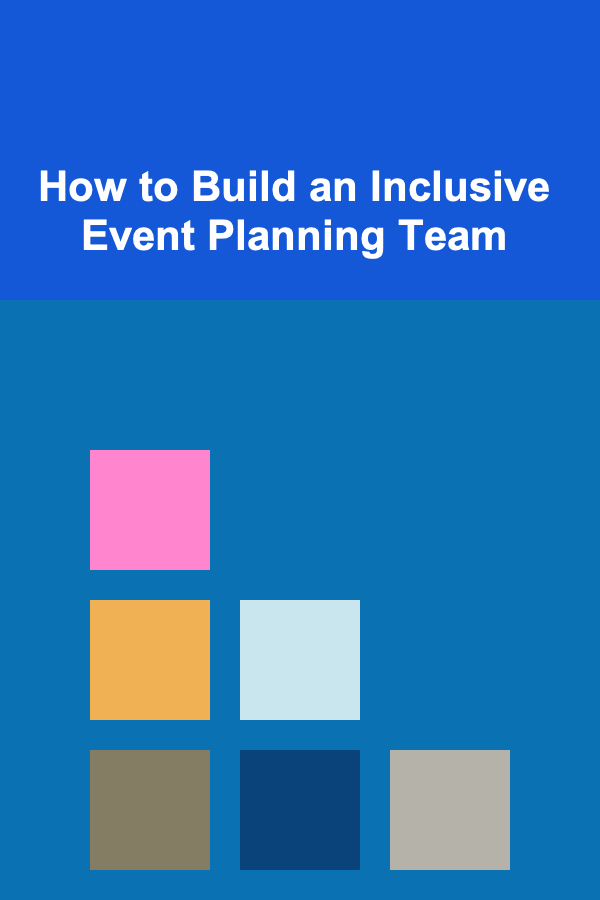
How to Build an Inclusive Event Planning Team
ebook include PDF & Audio bundle (Micro Guide)
$12.99$10.99
Limited Time Offer! Order within the next:

Building an inclusive event planning team is essential in today's diverse world. The inclusion of varied perspectives, backgrounds, and experiences in your planning process not only makes your event more innovative and engaging but also ensures that everyone feels seen, heard, and valued. Whether you're organizing a corporate conference, a community festival, or a wedding, an inclusive team can make all the difference in delivering an experience that resonates with a wide audience.
In this guide, we will explore the essential steps to building an inclusive event planning team, from recruitment and team dynamics to ensuring accessibility and creating a welcoming environment.
Step 1: Understand the Importance of Diversity and Inclusion
Before diving into the logistical aspects of building your team, it is vital to understand why diversity and inclusion matter. An inclusive event planning team goes beyond simply checking boxes; it involves intentionally bringing together individuals with different backgrounds, perspectives, and skills to enhance the overall planning and execution process.
1.1. The Benefits of an Inclusive Team
- Broader Perspectives: A team with diverse experiences and backgrounds is more likely to approach challenges creatively and find unique solutions. This can lead to more innovative ideas and a fresh outlook on event planning.
- Increased Representation: Events are for people, and when you build an inclusive team, you help ensure that the event represents a variety of voices, cultures, and identities. This can make your event more relatable and welcoming to a broader audience.
- Improved Collaboration and Team Morale: Inclusivity often leads to a more harmonious and collaborative environment. When team members feel valued and respected, it can boost morale and overall productivity.
- Enhance Brand Reputation: Being recognized for promoting inclusivity in event planning can enhance the reputation of your organization or brand, attracting a diverse audience and making your events stand out.
Step 2: Recruit a Diverse Team
The first and most critical step in building an inclusive event planning team is recruiting a diverse group of individuals. This involves looking beyond the surface-level criteria and focusing on creating a team with diverse backgrounds, expertise, and experiences.
2.1. Diverse Backgrounds
- Cultural Diversity: Ensure that your team is made up of people from different cultural, racial, and ethnic backgrounds. This will help you understand cultural preferences, traditions, and nuances that could influence how the event is perceived by attendees.
- Gender Diversity: Gender diversity is essential for bringing a variety of perspectives. Make sure that both men and women, as well as non-binary individuals, are included in your team.
- Age Diversity: A team made up of different age groups will bring varied generational insights to the planning process. This can help your event be more inclusive of people from various life stages.
- Socioeconomic Diversity: Having people from different socioeconomic backgrounds can provide a broader view of what might be accessible or affordable to your audience.
2.2. Skill Diversity
Along with demographic diversity, it's important to recruit individuals with varying skill sets. This ensures that your team has the full range of abilities needed to execute a successful event. For instance:
- Project Management Skills: A project manager will be essential for keeping the planning on track and ensuring that deadlines are met.
- Creativity and Design: People with creative expertise can help bring new and innovative ideas to the table for event themes, decor, and design.
- Marketing and Social Media Expertise: These team members will help ensure your event reaches the right audience through targeted promotions.
- Logistical and Operational Expertise: Individuals with strong logistical skills will handle the critical details such as venue coordination, vendor relationships, and transportation.
- Accessibility and Inclusion Knowledge: It's important to have someone on the team who specializes in accessibility. They will ensure that your event is welcoming to people with disabilities, whether that involves physical accommodations or digital accessibility.
Step 3: Foster an Inclusive Environment
Once your team is in place, it's important to foster an environment where everyone feels welcomed, heard, and respected. Building an inclusive culture within your team will ensure better collaboration and help prevent exclusionary behaviors.
3.1. Establish Clear Communication Practices
An inclusive event planning team requires clear and open communication. Establish channels where every team member feels comfortable sharing their ideas, thoughts, and concerns. This could include:
- Regular Team Meetings: Hold regular check-ins where team members can share updates and discuss any challenges they are facing.
- Feedback Loops: Create a safe space for team members to provide feedback on the planning process and the team dynamics.
- Active Listening: Encourage active listening within the team. When someone is speaking, ensure that others are truly listening and not dismissing or interrupting their ideas.
3.2. Promote Mutual Respect and Collaboration
Respect is the foundation of any inclusive team. Foster an environment where everyone feels that their contributions are valued, regardless of their position or background.
- Encourage Collaboration: Assign roles based on each person's strengths, but encourage collaboration across the team. Diverse perspectives should be seen as strengths, not barriers to productivity.
- Be Mindful of Microaggressions: Ensure that your team is educated about microaggressions and other subtle forms of exclusion. Offer training or workshops if necessary to raise awareness and prevent unintentional harm.
- Be Open to Feedback: Make it clear that everyone on the team has a voice, and that feedback is welcomed and valued. Foster a culture where feedback is constructive and not punitive.
Step 4: Ensure Accessibility at Every Stage
An inclusive event is not just about having a diverse planning team but also about ensuring that the event itself is accessible to all attendees. From the planning phase to the actual execution, accessibility should be top of mind.
4.1. Venue Accessibility
- Wheelchair Access: Ensure that the venue is wheelchair accessible, including ramps, elevators, and accessible bathrooms.
- Signage and Directions: Clear signage in multiple formats, such as large print, braille, or digital apps, can make the venue more accessible to those with visual impairments.
- Transportation and Parking: Ensure that there are accessible parking spaces and transportation options for guests with mobility challenges.
4.2. Catering to Dietary Needs
- Varied Menu Options: Include a variety of food options to cater to different dietary restrictions, including vegan, gluten-free, halal, kosher, and allergen-free options.
- Clear Labeling: Label food items clearly so that guests with dietary restrictions can easily identify what is safe for them to consume.
4.3. Communication and Interpretation
- Sign Language Interpreters: If your event involves speeches or presentations, consider providing sign language interpreters for guests who are deaf or hard of hearing.
- Captioning: Ensure that video content or presentations include captions for those with hearing impairments.
- Language Accessibility: If you have a diverse audience, consider offering multilingual support, either through translation or interpretation services.
Step 5: Incorporate Inclusive Marketing Strategies
An inclusive event planning team will also consider how to market the event in an inclusive way. This involves ensuring that your promotional materials and outreach are reflective of diverse communities and accessible to a wide audience.
5.1. Representation in Marketing Materials
Ensure that your marketing materials, such as flyers, posters, and social media posts, reflect the diversity of your team and the community you are serving. Use inclusive language and images that resonate with people from different cultural, racial, and social backgrounds.
5.2. Promote Accessibility in Marketing
Highlight the accessibility features of your event in your marketing materials. Include information about venue accessibility, available accommodations for people with disabilities, and how attendees can request special accommodations.
5.3. Engage with Diverse Audiences
Reach out to a wide variety of media outlets, organizations, and community groups that cater to diverse populations. This will help ensure that your event reaches all potential attendees and that your message resonates across cultural, ethnic, and socioeconomic lines.
Step 6: Evaluate and Improve
Once your event has concluded, it's essential to evaluate how inclusive your team was and how the event itself was perceived. Gathering feedback from both your team and attendees will provide valuable insights into areas of success and opportunities for growth.
6.1. Gather Feedback
Conduct surveys or hold post-event meetings to gather feedback on the event's inclusivity. Ask both your team members and attendees for their thoughts on what went well and what could be improved.
6.2. Review Team Dynamics
Assess how well the team worked together. Were all voices heard? Was anyone excluded from decision-making? Were there any unintentional biases or microaggressions that affected team morale or the event experience?
6.3. Continuous Improvement
Inclusivity is a journey, not a destination. Use the feedback you receive to continue evolving and improving your team dynamics and event planning processes for future events.
Conclusion
Building an inclusive event planning team is not just about diversity---it's about creating an environment where all voices are valued, and every person feels empowered to contribute their unique perspective. By taking steps to recruit a diverse team, foster inclusive communication, ensure accessibility, and promote inclusivity in your marketing, you can create events that are truly representative of and welcoming to everyone. The success of your event will not only reflect the quality of your planning but also the inclusiveness that permeates the entire process, leaving a lasting impact on all involved.
Reading More From Our Other Websites
- [Gardening 101] Top Garden Shed Designs to Maximize Your Outdoor Space
- [Toy Making Tip 101] STEM-Focused Toy Creations: Building Robots, Gadgets, and Learning Kits
- [Personal Financial Planning 101] How to Build a Strong Credit History for Financial Success
- [Home Security 101] How to Set Up a Virtual Security Patrol to Monitor Your Property 24/7
- [Home Maintenance 101] How to Effectively Remove Mold and Mildew from Your Bathrooms
- [Home Lighting 101] How to Create a Relaxing Bedroom Ambiance with Lighting
- [Home Renovating 101] How to Handle Home Renovation Permits and Legal Requirements
- [Home Staging 101] How to Use Color Psychology in Home Staging for More Appeal
- [Home Cleaning 101] How to Clean and Organize Your Garage
- [Personal Investment 101] Making Money with Deep Learning: A Beginner's Guide

How to Create a Checklist for Organizing Your Home's Electrical Cords: An Actionable Guide
Read More
How to Organize a Family Movie Marathon Weekend
Read More
How to Use Recessed Lighting to Illuminate Your Space
Read More
Unlocking Game Development Secrets: Techniques and Technologies for the Next Generation of Game Masters
Read More
How To Grasp the Progress in Parkinson's Disease Research
Read More
How to Make French Patisserie at Home
Read MoreOther Products

How to Create a Checklist for Organizing Your Home's Electrical Cords: An Actionable Guide
Read More
How to Organize a Family Movie Marathon Weekend
Read More
How to Use Recessed Lighting to Illuminate Your Space
Read More
Unlocking Game Development Secrets: Techniques and Technologies for the Next Generation of Game Masters
Read More
How To Grasp the Progress in Parkinson's Disease Research
Read More